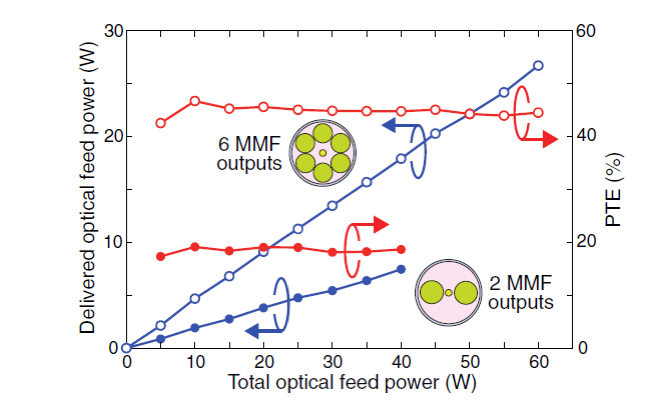Optical fibres to power mobile data networks
Researchers at the University of Electro-Communications in Tokyo, have reported the ability to supply 60W power over a 300m optical fibre system - demonstrating the potential of optical feed systems using double-clad fibres for future small cell mobile communications.
Increasing data use is placing greater demands on the radio antenna units that transmit data to mobile devices. Supplying power to these antenna units by the same optical fibre systems that transmit data signals to them could improve and simplify these infrastructures if the power supplied this way can be increased.
Now Motoharu Matsuura, Hidehito Furugori and Jun Sato at the University of Electro-Communications have demonstrated the ability to supply 60W over a 300m test fibre system, exceeding the power supplied in previous work and emphasising the potential of the approach.
Power supply over fibre is limited by the power transmission efficiency, which is impeded by the large fraction of power fed into the optical link that is lost as heat during transmission. As a result, restrictions on power feed levels are needed to prevent waste heat damaging optical components in the link.
Matsuura and colleagues had demonstrated that they could bundle together two multi-mode fibres for transmitting power with a double clad fibre for transmitting the data. This bundle was tapered and fused to a double clad fibre output. However, power was lost in the tapered fibre bundle divider due to the lower cross-sectional area occupied by fibre in the cluster bundle. As a result the overall power transmission efficiency was only 20% - limiting the power that could be fed into the link to just 40W.
Increasing the number of multi-mode power carrying fibres to six optimised the cross-sectional area of fibre in the bundle cluster without introducing other limitations, thereby maximising the power transmission efficiency. In their report the researchers conclude, “These results demonstrate that optical feed systems using double-clad fibres have high potential for practical use in future small cell mobile communications.”
Background - mobile data networks
Radio antenna units wirelessly transmit data from a central station to mobile devices at radio frequencies. The central station transmits data to the antenna units using radio over fibres.
The power for the radio antenna unit is usually supplied by the mains but the proposed power over fibre could simplify the power supply. In addition, power over fibre would leave the antenna units invulnerable to interruptions in mains power supply, such as during lightning damage. While power-over-fibre options have attracted the attention of researchers, so far the power available over fibre has been limited.
Test system details
The researchers tested their fibre cluster of power and data fibres in a bidirectional system consisting of a central station and a radio antenna unit linked by a double clad fibre.
A laser diode with direct electrical modulation from a signal generator produced test signals at 1,550nm to the standard specifications of the Institute of Electrical and Electronics Engineers (IEEE) for the wireless local access network (WLAN) used in Wi-Fi (specifications IEEE 802.11 g). Commercial laser diodes also fed the optical power.

Above: Delivered optical feed power and power transmission efficiency (PTE) as a function of total optical feed power launched from the two high power laser diodes. The solid circles show the results of the university’s previous scheme with a tapered fibre bundle divider consisting of two multi-mode fibre (MMF) outputs, while the open circles show the results obtained from this work with a tapered fibre bundle divider consisting of six MMF outputs. The insets illustrate how using a greater number of narrower MMFs leaves less empty space and increases their total cross section.
An erbium-doped fibre amplifier boosted the signal and increased the power level of the data signal for the transmission. The system also included elements to reduce the noise, including bandpass filters and cladding mode strippers.
The multi-mode fibres and the double clad fibre in the fibre bundle cluster input were tapered and fused to a 300m double clad fibre transmission output. The double-cladding prevents crosstalk. Expense prohibited use of a longer output double-clad fibre in the test system. Double-clad fibres are usually commercially produced for use as gain media, for which they do not need to be much more than 100m long.
Cross-sectional compromise
The researchers identified the combined cross-sectional area of the two multi-mode fibres as the limiting factor for power transmission efficiency. The two multi-mode fibres left empty space in the bundle cluster that was unoccupied by fibre, so that the total fibre cross-section was smaller than that of the double-clad fibre it fused to, making power transfer inefficient.
Using a greater number of narrower multi-mode fibres increases their filling factor within the bundle and hence their combined cross-sectional area. However, this also means each fibre is narrower, and this reduces the power handling capability of each fibre. The researchers determined that a bundle of six multi-mode power handling fibres gave the optimum compromise between the two limiting factors.










